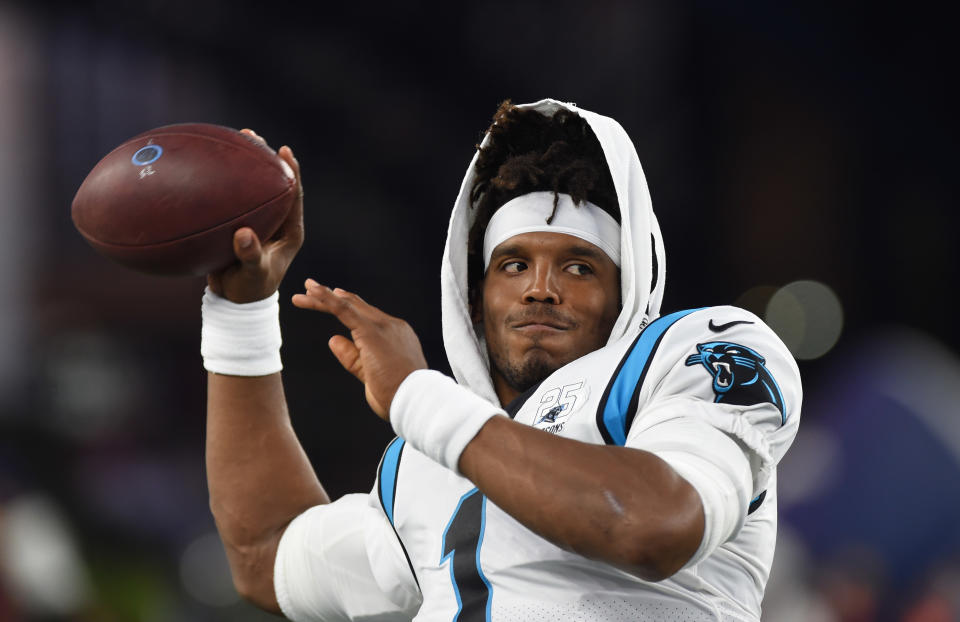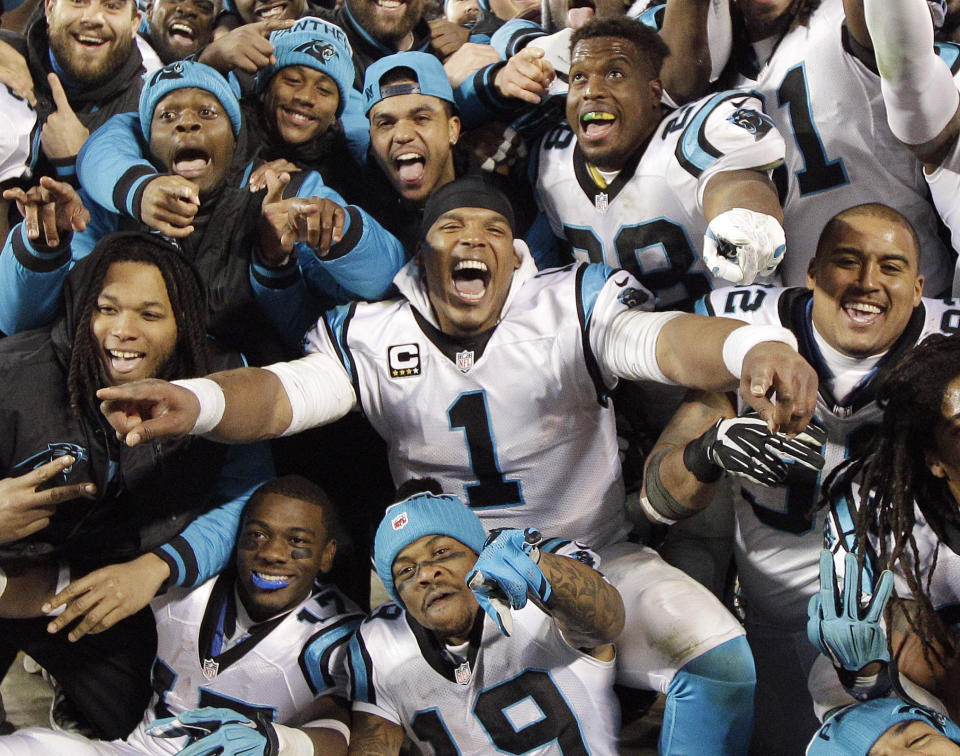Why are we debating if Cam Newton deserves his starting job back? It's obvious he should.
The time is nearly upon us. A moment is coming when the Carolina Panthers must look in the mirror and make a pivotal decision about their quarterback position. With whispers of Cam Newton rearing up to take part in practice soon, it’s only a matter of time.
The Panthers’ longtime franchise quarterback indicated almost a month ago on his official YouTube page that he was focused on getting back to 100 percent before returning to the field. If Newton indeed turns up at that level here in the next few weeks, the Panthers will have to choose whether they want to end the white-hot run of Kyle Allen and return to the player who they once took No. 1 overall in the NFL draft.
On the surface, it’s a tough debate. Despite Newton’s status as a former league MVP, it’s tough for a team to break what’s not in need of fixing. The Panthers are winning. Allen is playing well. How do you bench this guy? Well, you look not just at the current moment, but with clear eyes, you return to the memories of Newton’s time in Carolina and mold them with the potential of what may lie ahead. Upon that moment, the decision becomes abundantly clear.

Cam Newton’s detractors are being disingenuous
It has been nothing short of infuriating to watch piles of tweets and graphics scattered across the football media landscape comparing Allen’s starting stretch to the previous eight games we’ve seen of Cam Newton. Allen’s passing numbers and the team’s record under his watch are undoubtedly impressive. On the other hand, the sample collected with which we’re meant to judge Newton is utterly bereft of context or, frankly, any utility.
We all know that the back half of last season and his two starts in 2019 featured a Cam Newton that was playing through injury. His shoulder malady of 2018 eroded his game to the point where he couldn’t push the ball downfield. By the time we saw him in Week 2 this season, he was unrecognizably inaccurate as he gritted through a deteriorating foot condition. To set the selected games right at the moment as his health struggles began and therefore slice off the first eight games of 2018 is disingenuous at best and unscrupulous at worst.
Newton was in the middle of his most efficient season married with a 6-2 start for his team. It was just one year ago. That omission from this discussion is stunning because the reason for its existence is crucial to the Panthers’ impending decision.
It's bizarre to me the last stretch where we saw Cam Newton healthy, starting off 2018, just gets left off when people start offering up splits in the Kyle Allen debate.
Cam was on his way to a career year efficiency-wise in this offense with the new weapons before the injury. pic.twitter.com/BA5NbSjgAy— Matt Harmon (@MattHarmon_BYB) October 17, 2019
Newton’s 67.3 percent completion rate would have shattered his previous career high from his rookie season. His 5.7 touchdown rate would have gone down as the second-best of his career. That 100.8 passer rating would have marked the first time he hit triple-digits. All this while clearing seven yards per attempt, hardly turning into a dink-and-dunk machine. From a data perspective, this was peak Cam Newton; satisfying those who must worship at the metrics altar while also putting dazzling dimes on film.
To say we’ve never seen Newton transform his game to that of an effective passer who doesn’t rely on his legs first is flat-out wrong. If you want to do it, you have to just wipe half of a season completely from the ledgers of time.
All we’ve heard throughout Newton’s time in the NFL was persistent chirping about that low completion percentage. Often tossed around as a fatal flaw, signs of his inaccurate nature, used as “told-you-so” fodder by his ardent doubters. And yet, the time of his career when he posted a strong completion percentage, and not just by his standards but at a top-10 level by league standards, is left off this narrative. Again this is ridiculous because it was no coincidence that it came in those eight games.
Carolina’s offensive reboot was taking shape
Cam Newton did not come by the Superman moniker simply by means of his branding strategy. The Panthers all too often asked him to be that hero. Carolina never did its franchise quarterback justice when it came to collecting weaponry in the passing game. Receiver corps littered with middling youngsters mixed with vagabond veterans were a staple of the lost Steve Smith years in Charlotte. It was no more apparent than when a wideout room of Ted Ginn, Philly Brown and Jerricho Cotchery was dragged to the Super Bowl by Newton in his MVP season.
Even as the Panthers brass under Dave Gettleman spent high draft equity at the position, the issues continued. Hulking receivers Kelvin Benjamin and Devin Funchess were selected as part of a painful overcorrection to fix Newton’s one or two brutal high throws per game. Their lack of separation caused problems that were exacerbated by Mike Shula’s offense and its glaring lack of layup passes.
Not many quarterbacks have been tasked with making high-degree-of-difficulty deep throws near the sideline to receivers who struggle to get open at a higher rate than Newton. That’s been the reality of his career, until 2018.
Last season saw the Panthers finally put together an offense to bring out the best in their talented quarterback’s passing ability. Instead of pulling a solution like “get big targets to fix his accuracy” out of the netherworld of folly, Carolina’s front office finally began stacking players who could earn quick separation. As the personnel turned over, the organization brought in Norv Turner to scrap the woebegone portions of the playbook and accomplish one directive: Evolve Newton’s game, make his life easier. And so it was.
In 2018, route-running aficionado Christian McCaffrey was blossoming into full form. His unique ability as a receiver was crucial in providing never before offered quick-hitting layup throws for Newton, who fed him at a 100-plus target pace. Rookie receiver D.J. Moore was an instant hit, especially as a middle-of-the-field player with juice after the catch. As the year went on, second-year wideout Curtis Samuel began to flash his potential as a full-field route runner. Even the offensive line wasn’t a depleted hellscape, as it’s too often been during Newton’s tenure.
The stretch of games last year is not just a randomly selected outlier sample of Newton’s career. It was the onset of a plan finally brought to fruition. The early stages of penance for the sins of the Panthers in failing to provide Newton with proper assistance for far too long. The validity of it showed in the data and more important, in the win column.
The crazy part is that ecosystem still exists today. Hell, it’s even stronger. All those players mentioned from McCaffrey to Moore to Samuel are even better one year later. Greg Olsen is back and looking rejuvenated after two years of foot injuries. The pass protection is starting to tighten up after injuries forced backups into the lineup to start the year. It’s easily the best offensive environment ever assembled in the Ron Rivera era in Carolina. If you think that’s not a big part of why Allen looks so good on the stat sheet, you’re fooling yourself. It’s no disrespect to Allen, who has done more than enough to keep the ship afloat. It’s just the reality.

Ceiling is higher for Newton than Kyle Allen
Making the playoffs is nice but a season is ultimately a failure if you’re a contender and don’t hoist the Lombardi Trophy. We’re at a place in the NFL where there’s about half the league that could have a good enough floor to fall between 10-6 to 8-8 and with luck, get into the playoffs. That doesn’t matter. It’s not a team’s floor that makes one a serious contender to win a Super Bowl, it’s their ceiling.
It’s not up for debate that a healthy Newton brings a higher ceiling to the Panthers than Allen, even at his best. The Panthers are one member of that big bulk of teams that could slither its way into the postseason. If they want to not just earn that spot but have it mean something, then their fate rests in the arms of Cam Newton.
Beyond a quest for a Super Bowl, the reality here is that the Panthers don’t just owe it to Newton to finally get a chance to drive the car they’ve finally built to bring out the best in him; they owe it to themselves. Newton is the most popular player in franchise history. He brought attention and national fame to the Panthers with his star power. Under his watch, they’ve generally been a playoff contender ever year. All that was while playing with that one arm tied behind his back.
If the Panthers don’t go back to Newton when he’s healthy, then what was the point of any of this? The opportunity to give their treasured franchise figurehead the offense he has so long deserved and always been deprived of will wash away. His era would end with the stench of “what-could-have-been” queries from keen observers.
With the context of his history square and the potential of what could lie ahead in mind, there is no debate here. The Panthers must turn back to Cam Newton when he’s healthy.
More from Yahoo Sports:

 Yahoo Sports
Yahoo Sports 
